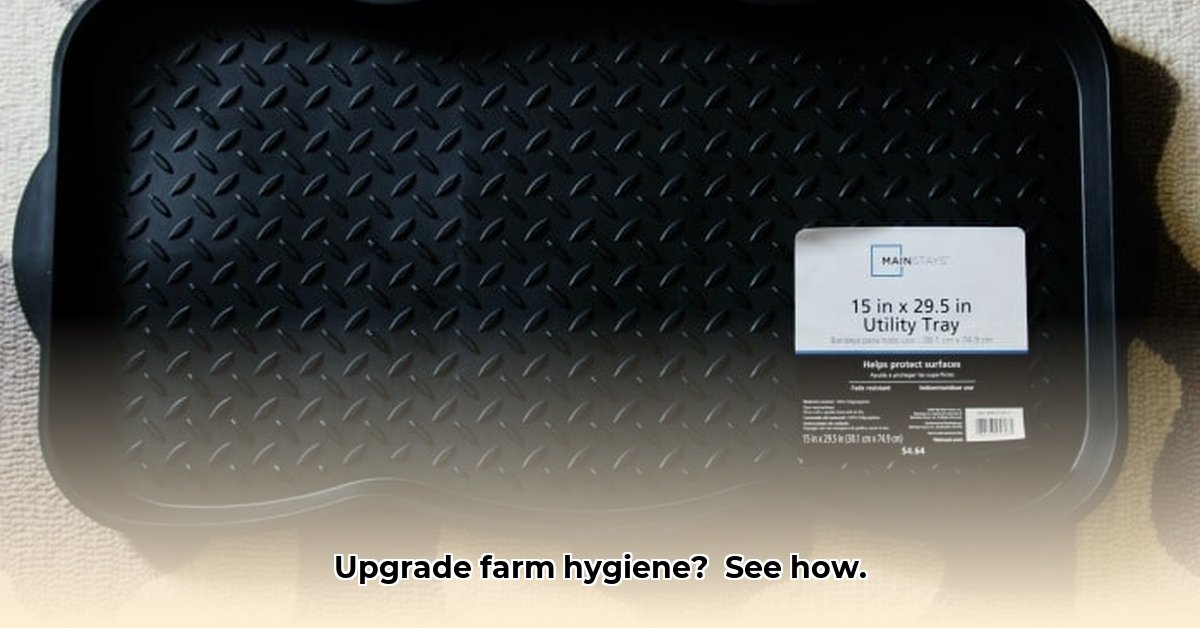
Muddy boots are a universal farming challenge, but tracking dirt and pathogens indoors isn't just messy; it impacts hygiene, efficiency, and long-term sustainability. This guide shows how simple boot trays, readily available at Tractor Supply, can significantly improve your farm's cleanliness and contribute to more sustainable practices. We'll cover selecting the right tray, strategic placement, effective cleaning, and the broader benefits for farm hygiene and the environment. For additional resources on sustainable farming practices, check out this helpful guide on straw bedding.
Choosing the Right Boot Tray: A Smart Selection
Selecting the perfect boot tray isn't complicated, but careful consideration of your needs pays off. Factors like budget, available space, and required durability are key. Think of it like selecting work boots – the right fit makes all the difference.
| Feature | Rubber Boot Tray | Metal Boot Tray | Plastic Boot Tray |
|---|---|---|---|
| Cost | Lower upfront cost | Higher initial investment | Moderate upfront cost |
| Durability | Good, but may degrade with harsh chemicals | Extremely durable, resists most damage | Moderate durability; susceptible to cracking |
| Cleaning | Easy to clean, often dishwasher-safe | Easy cleaning, but might need more robust methods | Easy to clean, but may require specific cleaners |
| Weight | Lighter, easier to move | Heavier, provides more stability | Lightweight, easy to move |
| Environmental Impact | Moderate (depends on recycling) | Higher (metal production and disposal) | Moderate (depends on material and recycling) |
Tractor Supply offers a diverse range; browse their catalog for the best fit. Seasonal sales might offer significant savings.
Setting Up Your Boot Tray System: A Step-by-Step Guide
Installing boot trays is straightforward, but strategic placement is crucial for maximum impact. Follow these steps for optimal results:
Strategic Placement: Position trays at all main entrances to barns, sheds, and other high-traffic areas. Consider the natural flow of foot traffic. Where do people enter and exit most frequently?
Easy Access: Ensure easy, unobstructed access. Make it convenient to use; otherwise, they become ineffective.
Appropriate Sizing: Choose the right size. Too small invites bypasses; too large wastes space. Consider the number of workers and traffic flow.
Regular Cleaning: Establish a routine—daily is best, but weekly is a minimum. Cleaning methods depend on the material; always follow manufacturer instructions.
Maintenance and Replacement: Regularly inspect for wear and tear. Replacing damaged trays is essential for maintaining hygiene and safety. A damaged tray is ineffective.
The Bigger Picture: Boot Trays and Sustainable Farming
Boot trays represent a small investment with large returns. They are a key component of sustainable farming. Preventing the spread of disease and invasive species minimizes resource use, reducing the need for extensive cleaning and promoting a healthier environment. This also contributes to improved worker safety and morale.
"Investing in a good boot tray system is a small step with big consequences for farm sustainability," says Dr. Emily Carter, Agricultural Engineer at Purdue University. "It's about minimizing waste, improving efficiency, and creating a healthier working environment."
Unexpected Benefits of Boot Trays: Beyond Cleanliness
The advantages of boot trays extend beyond simply cleaner floors:
Improved Operational Efficiency: Less cleaning time translates to increased productivity.
Reduced Cleaning Costs: Fewer messes mean less water, soap, and labor.
Enhanced Work Environment: Cleanliness boosts morale and professionalism.
Safety Improvement: Preventing slips and falls on muddy surfaces reduces accidents.
Has your farm experienced an increase in productivity since adopting boot trays? Let us know your experience in the comments!
How to Choose the Most Sustainable Boot Tray for Your Farm
Let's dive deeper into selecting the most eco-friendly option for your farm.
Key Considerations:
- Material: Consider the material's durability, recyclability, and overall environmental impact. Rubber and recycled plastic are often good choices. Durable materials minimize long-term environmental impact through less frequent replacement.
- Size and Placement: A properly sized and strategically positioned boot tray maximizes its effectiveness.
- Cleaning: Simple cleaning and maintenance extend the tray's life, reducing waste.
Material Matters: Durability and Sustainability
The lifespan and environmental impact of your boot tray are directly linked to its material:
- Rubber: Durable, weather-resistant, and easy to clean, often a sustainable choice.
- Recycled Plastic: Cost-effective and environmentally conscious. Look for recycled content labeling.
- Metal: Exceptionally durable but heavier, potentially more expensive, and requires careful consideration of rust prevention.
Choose recycled or easily recyclable materials whenever possible to minimize environmental impact.
Size and Placement: Maximizing Effectiveness
The effectiveness of your boot tray hinges on proper size and placement:
- Strategic Placement: Position trays at all main entry points, ideally undercover for better protection.
- Adequate Size: Ensure it's large enough for comfortable use by all workers, preventing mud from spilling around the tray.
Proper placement minimizes dirt tracking, simplifies cleaning, and promotes a cleaner, safer environment.
Cleaning and Maintenance: Extending Tray Life
Regular cleaning is crucial for longevity and hygiene:
- Daily Cleaning: Brush off excess mud daily.
- Periodic Deep Cleaning: Thoroughly clean weekly with soap and water to remove stubborn dirt and prevent bacteria buildup.
Effective cleaning practices contribute to sustainable farming by extending the lifespan of the trays and minimizing waste.
Choosing a sustainable boot tray involves finding the right balance between durability, ease of cleaning, size, and material. Prioritize durable, long-lasting options from recycled or recyclable materials and remember that correct placement and regular cleaning are key to its success and contribution to sustainable agriculture.